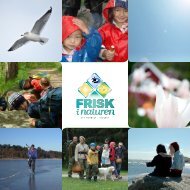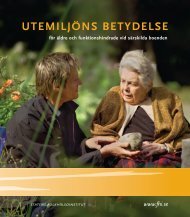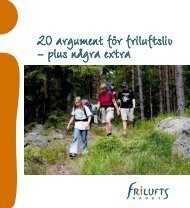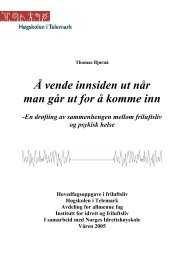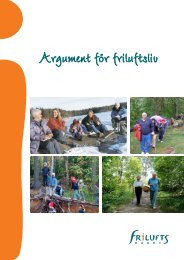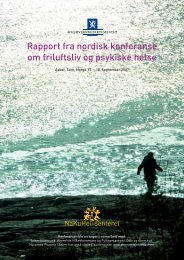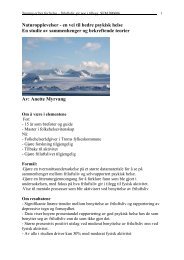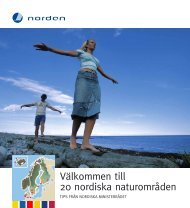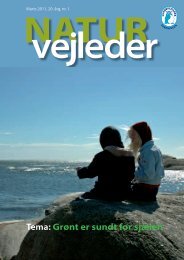Green Care: A Conceptual Framework - Frisk i naturen
Green Care: A Conceptual Framework - Frisk i naturen
Green Care: A Conceptual Framework - Frisk i naturen
Create successful ePaper yourself
Turn your PDF publications into a flip-book with our unique Google optimized e-Paper software.
Neuberger (2007), working with psychiatric patients, gives examples<br />
(pp.157-158) of specific horticultural activities that produce what he calls<br />
“correlating personal experiences”. For example, soil preparation may<br />
induce the psychic experience of a new beginning, a fresh start. In each<br />
of these approaches to therapy, the aim is to encourage clients to connect<br />
with nature and the role of the therapist is to facilitate the client to make<br />
that connection and to perceive it as valuable therapeutically. There is a<br />
therapeutic triangle here: the therapist, the client and connection with the<br />
natural environment are part of the therapy process. In a later section in this<br />
volume, the importance of the quality of the relationship between people in<br />
green care settings will be examined further.<br />
2.4 Defining the construct of care<br />
One of the distinctions that can generally be made between green care<br />
and other activities that people undertake within the natural environment<br />
(walking, rambling, canoeing, mountain biking and so on) is that green care<br />
is intended to provide a range of (sometimes specific) benefits for particular<br />
client groups. Other activities within nature may contribute to people’s<br />
health and well-being in a general way but even if they are organised there<br />
may often be little or no emphasis on ‘care’ and therapeutic outcomes.<br />
Once such activities become focused on helping vulnerable people achieve<br />
specific outcomes they move into the realms of green care.<br />
<strong>Green</strong> care in all its forms focuses on providing nature-based benefits<br />
for various groups of vulnerable or socially excluded people. There are,<br />
however, differences in the level of ‘care’ provided by different green care<br />
options. Some operate as structured therapy programmes (for example,<br />
horticultural therapy and animal assisted therapy) with clearly stated<br />
patient-orientated goals whilst others aim to deliver more wide-ranging<br />
benefits. However, these too are aimed at specific groups and individuals<br />
rather than at casual participants who may be unaware of the ‘therapeutic’<br />
intent.<br />
Ostensibly, the same medium or environment may be used for both the<br />
specific therapies and for the promotion of broader aims. Animal assisted<br />
therapy, for example, uses contact with animals as a tool for the therapist<br />
to work with individual clients and address particular areas of difficulty,<br />
whilst care farms use animals in the farm setting for wider benefits resulting<br />
from meaningful occupation, opportunities to nurture and so on.<br />
21



